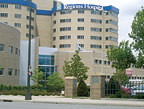
Regions Hospital is a leading Trauma Level I hospital, recognized nationally for its programs in heart health, women's care, cancer, surgery, digestive care, seniors' services, behavioral health, burn treatment, and trauma services. In addition to its 1.2 million-sq-ft wing campus in St. Paul, the hospital also operates numerous affiliate clinics and specialty care facilities in the region.
Chronic Chiller Problem Becomes Acute
At the main campus, the growing problem of an aging chiller plant was brought to acute status by plans to add a 140,000-sq-ft wing to the main hospital. The existing chiller plant was in a physical plant building adjacent to the hospital. This building also houses the boiler plant and standby electric generation. The chiller plant included three centrifugal chillers, which had insufficient combined capacity to serve the building addition.
Additionally, the three machines were using well water as a condenser cooling medium. The permit from the State of Minnesota for this application was expiring and the hospital needed an alternative method. The evaluation of the existing plant and the mechanical design for the upgraded facility was done by Michaud Cooley Erickson (MCE), a Minneapolis design firm. Their engineering analysis indicated that two of the older chillers could not be converted to conventional cooling tower operation, hence would need to be replaced. According to maintenance department manager Steve Marah, the imminent need for capacity to serve the new wing made the decision even more urgent. "It came down to three issues: losing the groundwater permit, the concern about plant reliability with aging plant equipment, and the upcoming need for more capacity to serve the new wing."
Efficiency, Reliability Both Concerns
According to Marah, the selection process for plant equipment focused on a variety of concerns. "Operational efficiency was important, and so was the need for a highly reliable plant." Barnaal pointed out another consideration. "We are quite limited on space here. We wanted to be able to fit significantly increased capacity into our existing physical plant building. That was also very important."The project also involved installation of cooling towers to supply the new chillers, as well as one older 1,200-ton Trane Model CVHE chiller, which was kept in service. The tower selected was a five-cell Baltimore Air Coil unit. Each cell has a capacity of 960 tons. Here again, space for the towers adjacent to the building was a concern. For this reason the engineering department hoped to minimize the footprint of the cooling tower.
Barnaal pointed out another criterion for the new chillers - acoustics. "We hoped to be able to get units that didn't add significantly to the noise level in the plant building. That makes working here a lot more pleasant." The mechanical design for the upgraded facility was done by MCE. Barnaal indicates that the hospital looked at a wide variety of solutions for the chiller replacement, and ultimately decided on two Trane Duplex CenTraVac™ centrifugal chillers as the optimum solution. The two chillers, rated at 1,800 tons each, are direct-drive, two-stage, low-pressure machines.
Condensing Sections Run in Series
These units are called "duplex" because they each have two compressors and control panels. As they were configured in this application, the condensers for the chillers ran in parallel to the cooling tower, with a design range of 85°F to 99°. The evaporators, however, were run in series to deliver chilled water at 43°. Marah noted that the system could actually deliver substantially colder chilled water, but at the present time the downstream air handlers may not be set up for these colder temperatures. As the airside plant is upgraded, or if additional capacity is needed, the chiller can be set for these lower temperatures, with no increase in the pumping requirement.The chillers were chosen because of their high efficiency - .45 kW/ton - and their ability to operate with relatively low condensing water flows. This low condensing water characteristic helped the hospital minimize the space requirement as well as the expenditure for cooling towers. Thanks to the chiller installation and other upgrades, the hospital is now well positioned for the future. ES
